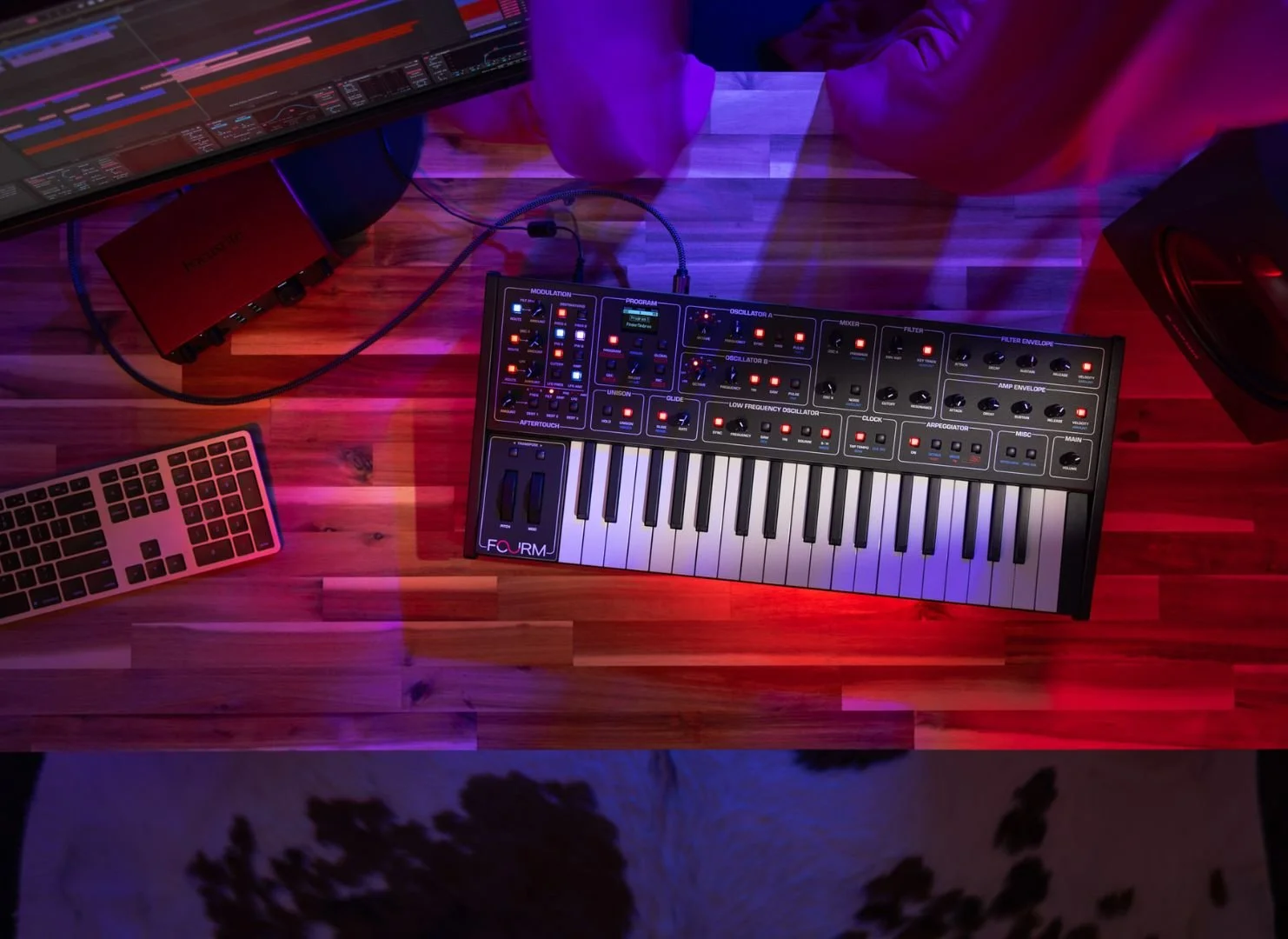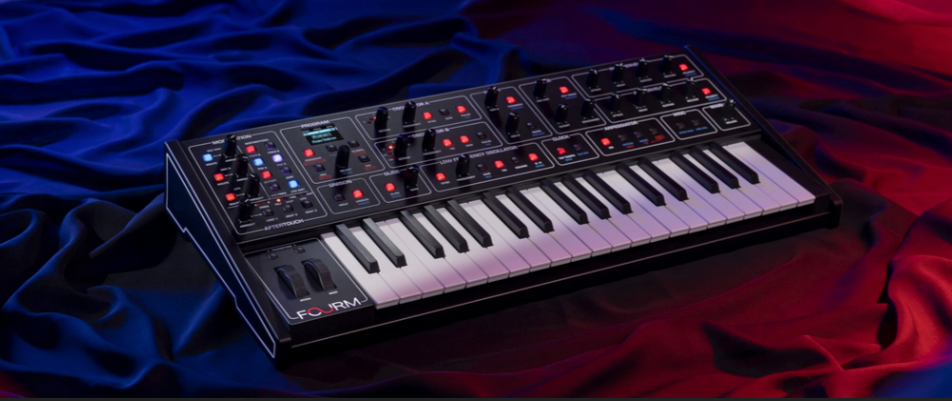Sequential Fourm: Is This Synth a Budget Prophet in Disguise?

Sequential is back with a synth that’s already turning heads: the new Fourm. At first glance it’s a compact 4-voice analog instrument, but there’s a catch — this is the most affordable Sequential poly yet, priced reasonably, and it ships with a brand-new slim-keybed that supports polyphonic aftertouch. For a company best known for instruments like the Prophet-5 and recent collaborations such as the OB-X8, it feels like a bold move into new territory. On paper, Fourm is stripped down compared to Sequential’s heavy hitters. It doesn’t drown you in voices or layers of digital effects, and that’s part of its pitch. Instead, it leans on Prophet-inspired analog circuitry, an intuitive modulation matrix, and an expressive keybed that rewards hands-on playing. The result is an instrument that feels like a cross between a modern performance synth and a callback to Dave Smith’s leaner designs. In this post, we’ll dig into what makes Fourm stand out, how it actually sounds, and where it fits alongside Sequential’s other gear.
This site contains affiliate links. If you book or purchase through these links, I may earn a commission at no extra cost to you. This helps support the site and keeps my content free. As an Amazon Associate, I earn from qualifying purchases.
What Makes Fourm Different
The headline with Fourm is its mix of price and expression. Sequential instruments have always carried a certain prestige — and usually, a premium price tag. At $999, Fourm is the company’s most affordable polyphonic analog synth to date, but it doesn’t feel like a cut-down toy. It delivers a fully analog signal path with dual oscillators, a 4-pole low-pass filter, and envelopes and filter behavior inspired by the Prophet-5, putting real Sequential tone within reach for a wider group of players.
What really separates Fourm is its new Tactive™ slim-key keybed, which offers polyphonic aftertouch. That means each note in a chord can respond individually to pressure, opening up expressive gestures that were once reserved for boutique controllers and flagship synths. At this price, it’s a rare feature, and it shows Sequential is willing to innovate in ways that aren’t just retro-reissues.
Fourm also leans into immediacy. Instead of complex menu systems, it gives you a knob-per-function layout and a Pro-One inspired modulation matrix with color-coded buttons. It’s the kind of synth you can learn in a session but keep exploring for months, balancing that classic Sequential warmth with a workflow that doesn’t slow you down.
How Fourm Actually Sounds
Sequential is framing Fourm as a compact instrument, but the sound it delivers is anything but small. Thanks to the Prophet-inspired voice design, the tone is warm, musical, and unmistakably analog, with plenty of weight in the low end and a smoothness in the filter that recalls the company’s classic polys. Even with only four voices, the instrument can move from bold bass lines to lush pads — as long as you keep your chord voicings tight.
Where things get interesting is in the way Fourm responds to playing dynamics. With polyphonic aftertouch, you can hold down a chord and bring individual notes alive by pressing harder: a filter sweep on one, vibrato on another, a bit of drive on a third. It’s the kind of subtle control that makes the synth feel expressive and performance-ready in a way that sample-based or strictly digital instruments rarely manage.
The onboard feedback and overdrive circuit also adds grit when you want it. Push it and you move from silky Prophet-style tones into more aggressive, modern textures — perfect for techno stabs, gnarlier basses, or cutting leads. While Fourm doesn’t come stacked with digital effects, the raw sound is strong enough to stand on its own, and it takes external processing beautifully if you want to push it further.
Playing and Tweaking Fourm
The layout of Fourm feels like a deliberate throwback to the days when every parameter lived right under your fingertips. Sequential has gone for a knob-per-function design, so shaping sounds is quick and intuitive. There’s no endless scrolling through pages of menus; everything you need to dial in a patch is right there, with the Pro-One style modulation matrix providing a fast way to route sources to destinations. It’s the kind of setup that makes you want to experiment instead of just scrolling presets.
The star of the performance side is the new Tactive™ slim-key keybed. It’s not a full-size action, which might be divisive, but the payoff is polyphonic aftertouch built directly into the hardware. That means every key can become its own expressive controller. For live players, it’s a revelation: you can lean into a single note of a chord for vibrato while another blooms with a filter swell, creating movement that would normally take a pair of hands and a modulation wheel.
On top of that, Fourm includes a feedback and drive circuit that responds beautifully to tweaking. A clean pad can transform into a biting lead just by nudging the drive, and basses can shift from rounded to snarling in seconds. Combined with the straightforward interface and modulation options, Fourm invites you to play it like an instrument rather than just a preset machine — a quality that’s becoming rarer in modern synth design.
Where Fourm Comes Up Short
As exciting as Fourm is, it’s not without compromises. The most obvious is the four-voice polyphony. For basses, leads, and tight voicings, it’s more than enough — but if you’re after sprawling pads or dense chords, you’ll hit the ceiling fast. Sequential has clearly positioned Fourm as a focused instrument rather than a do-it-all workstation, and that means learning to embrace its limitations as part of its character.
The other potential sticking point is the slim-key keybed. While it enables polyphonic aftertouch at an unheard-of price, players who prefer the feel of full-size keys might find it a little lightweight. For studio producers who mainly sequence from a DAW, this won’t matter much, but live performers could see it as a trade-off: greater expression in exchange for a less traditional feel under the fingers.
Finally, Fourm keeps things lean on extras. There’s no onboard reverb, delay, or chorus — the kind of bread-and-butter effects that many modern polysynths include. Instead, you’re working with a raw analog tone plus drive, which is powerful but may require outboard or in-the-box processing to polish into a finished track. Depending on how you look at it, that’s either a limitation or an invitation to shape the sound in your own way.
Sequential Lineage: How Fourm Fits In
Hearing that Fourm is a four-voice analog synth might bring back memories of the Mopho x4, a compact poly Dave Smith released over a decade ago. The Mopho stood out in its day for its sub-oscillators, deep modulation, and built-in step sequencer, making it a self-contained performance machine. Fourm shares the spirit of offering a smaller, more affordable Sequential instrument, but it takes a very different approach: stripping away the sequencer and complex routings in favor of immediacy, a knob-per-function layout, and something Mopho never had — polyphonic aftertouch.
That said, the more relevant comparison today is to Sequential’s Take 5. Both instruments are designed to bring Sequential’s analog tone to a wider audience, but they do it in distinct ways. Take 5 gives you an extra voice, digital effects, and more modulation flexibility, making it a well-rounded studio tool. Fourm, by contrast, keeps things lean — no built-in effects, no sequencer — but introduces expressive control at the keybed itself. In practice, Take 5 is the more versatile pick for players who want an all-in-one polysynth, while Fourm is about raw tone and tactile performance.
Tonally, Fourm leans closer to the Prophet-5 lineage, with smoother envelopes and filters that highlight Sequential’s heritage. It feels like a “gateway poly” — an instrument that captures the classic sound and adds modern expression without the footprint or price of a Prophet-10 or OB-X8. Where Take 5 is the Swiss Army knife, Fourm is the focused blade: smaller, sharper, and designed to cut into expressive playing in a way that no other Sequential offers at this tier.
Alternatives
If you’re looking at Fourm, the most obvious rival in its price tier is the Korg Minilogue XD. Like Fourm, it offers four voices, but it takes a hybrid approach with digital multi-oscillators alongside its analog core. The Minilogue also comes with built-in effects, which makes it an attractive all-in-one option. Where it falls short is in expression: it doesn’t have polyphonic aftertouch, and its overall tone is more polished than the raw analog character of Fourm.
Another strong contender is the Oberheim TEO-5, which brings five voices of true analog polyphony in a similarly compact format. It sits at a higher price than Fourm, but the extra voice and Oberheim’s distinctive tone will appeal to players who want slightly more harmonic flexibility. Still, Fourm’s polyphonic aftertouch gives it a unique edge in terms of playability at this level.
If you’re willing to spend more, the Novation Peak and Arturia PolyBrute push into higher price brackets but are often compared with smaller polys. Peak offers eight voices, hybrid digital oscillators through analog filters, and a deep modulation matrix with built-in effects — a powerful studio tool if you need breadth over immediacy. The PolyBrute doubles down on expressivity, with six voices, morphing patch architecture, and the Morphée touch controller, but it’s much bulkier and more expensive. Fourm positions itself as a leaner alternative: compact, affordable, and the only synth under $1,000 with true analog voices and polyphonic aftertouch.
Pros and Cons
Pros
Most affordable Sequential poly to date ($999)
Fully analog signal path with Prophet-inspired tone
Polyphonic aftertouch via the new Tactive™ slim-keybed
Knob-per-function layout, minimal menu diving
Pro-One style modulation matrix makes routing quick and clear
Feedback/drive circuit adds grit and versatility
Compact, portable form factor
Cons
Only four voices of polyphony — limiting for pads and complex chords
Slim-keys may feel less satisfying than full-size keys
No built-in effects like reverb or delay
Lacks onboard sequencer or arpeggiator
Stripped-down compared to deeper Sequential models (Take 5, Prophet series)
Final Words
The Fourm is a fascinating addition to the Sequential lineup — not because it tries to compete with their flagships, but because it dares to do less while still feeling inspiring. By keeping the voice count low and trimming extras like built-in effects, Sequential has managed to hit a price point that makes their analog sound more accessible than ever. And with the addition of polyphonic aftertouch, it doesn’t just feel like a budget option — it feels like a forward-looking instrument.
Of course, the limitations are real. Four voices won’t satisfy every player, and the slim keys may split opinion. But if you approach Fourm for what it is — a compact, expressive analog synth that captures the essence of Sequential tone — it starts to make sense. This isn’t a Prophet replacement; it’s a gateway Sequential for players who want hands-on sound design, tactile performance, and a taste of polyphonic aftertouch without breaking the bank.
This site contains affiliate links. If you book or purchase through these links, I may earn a commission at no extra cost to you. This helps support the site and keeps my content free. As an Amazon Associate, I earn from qualifying purchases.


